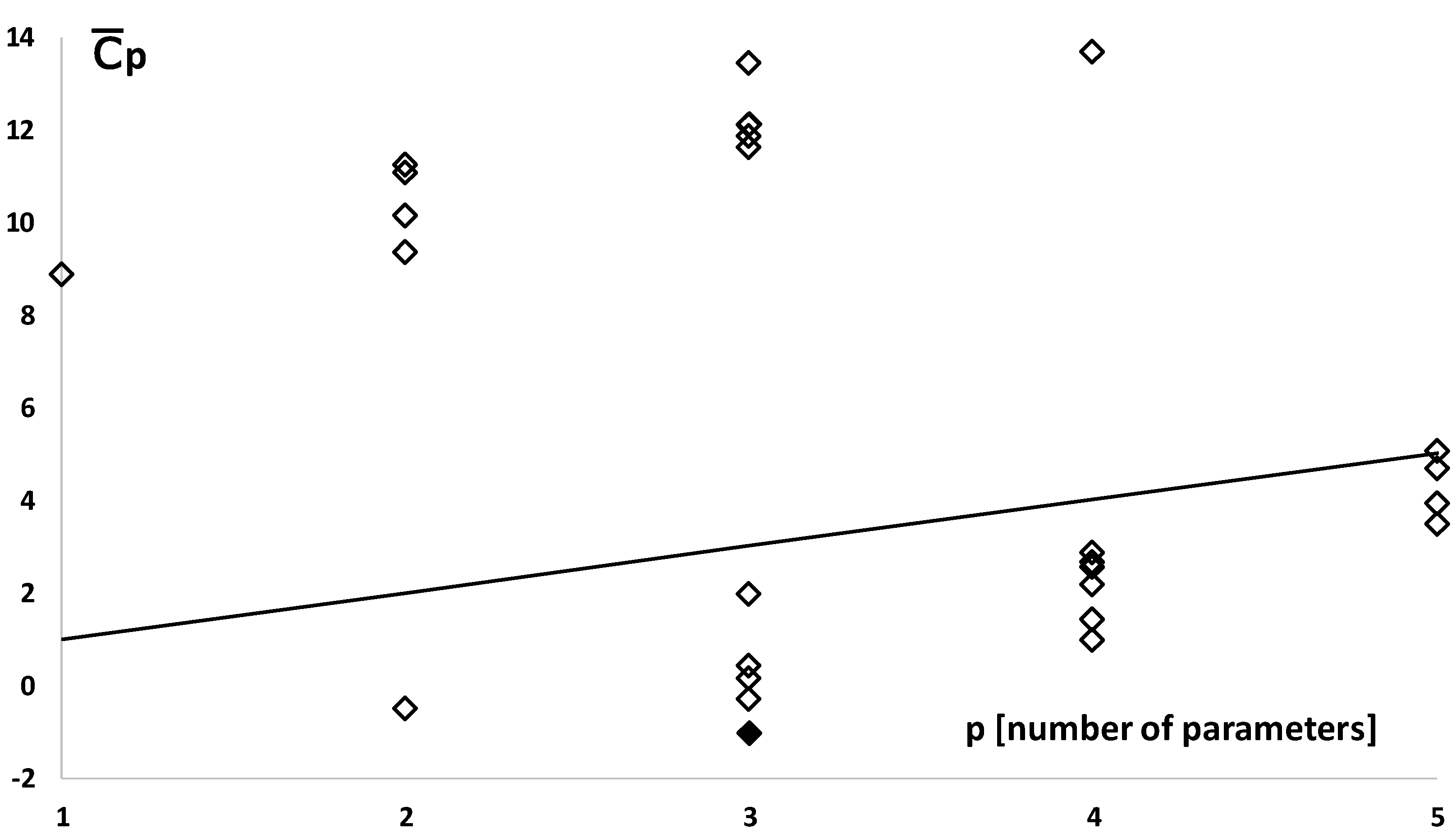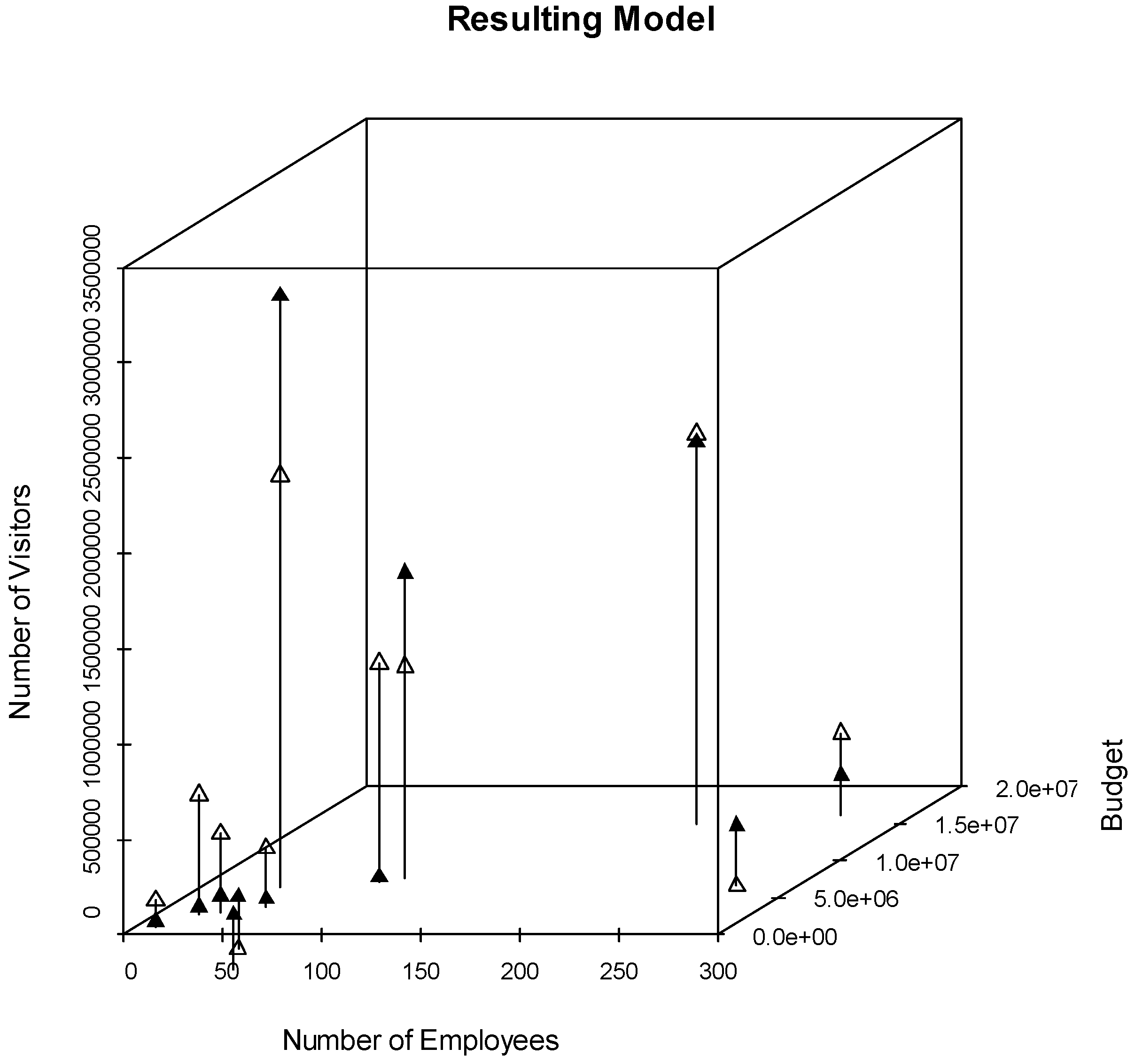Factors Affecting the Number of Visitors in National Parks in the Czech Republic, Germany and Austria
Abstract
:1. Introduction
2. Methods
2.1. Data Collection
- Area—x1
- Number of Employees—x2
- Budget—x3
- Average Salary—x4
- Number of Researchers—x5
- Number of Visitors—y (as explained variable)
2.2. Data Analysis
2.3. Data Processing
3. Results
3.1. Data Description
3.2. Analysis of Number of Visitors
- x2—Number of Employees ( = 11.25);
- x3—Budget ( = 9.38);
4. Discussion
Acknowledgments
Author Contributions
Conflicts of Interest
References
- Europarc, F. (Ed.) Living Parks, 100 Years of National Parks in Europe; Oekom Verlag: München, Germany, 2009. [Google Scholar]
- Antara, S.; Darnell, A.; Crowe Ian, J.; Bateman Munday, P.; Foden, J. Economic Assessment of the Recreational Value of Ecosystems in Great Britain: Report to the Economics Team of the UK National Ecosystem Assessment; The Centre for Social and Economic Research on the Global Environment (CSERGE), University of East Anglia: Norfolk, UK, 2011. [Google Scholar]
- Suh, J.; Harrison, S. Management Objectives and Economic Value of National Parks: Preservation, Conservation and Development; Discussion Paper; The University of Queensland: Queensland, Australia, 2005. [Google Scholar]
- Stemberk, J.; Stemberkova, R.; Marešová, P.; Kuča, K. Organizational Structure—A Case Study on the National Parks in the Czech Republic. In Psychology and Psychiatry, Sociology and Healthcare, Education (SGEM 2015); ProQuest Publishing: Sofia, Bulgaria, 2015; pp. 629–637. [Google Scholar]
- Stemberk, J.; Stemberkova, R.; Marešová, P.; Kuča, K. Personnel Management on the Example of Selected National Parks in Germany; International Business Information Management Association: Sevilla, Spain, 2016. [Google Scholar]
- Stemberk, J.; Stemberkova, R.; Marešová, P.; Kuča, K. Analysis of Efficiency of Management of National Parks—“Best Practice”—A Case Study on the National Parks Sumava and Bayerischer Wald; International Business Information Management Association: Sevilla, Spain, 2016. [Google Scholar]
- Balmford, A.; Beresford, J.; Green, J.; Naidoo, R.; Walpole, M.; Manica, A. A global perspective on trends in nature-based tourism. PLoS Biol. 2009, 7, e1000144. [Google Scholar] [CrossRef] [PubMed]
- Manning, R.E.; Lawson, S.; Newman, P.; Halo, J.; Monz, C. Sustainable Transportation in the National Parks: From Acadia to Zion; University Press of New England: Lebanon, NH, USA, 2014. [Google Scholar]
- Bateman, I.J.; Abson, D.; Beaumont, N.; Darnell, A. Chapter 22: Economic Values from Ecosystems UK National Ecosystem Assessment: Understanding Nature’S Value to Society; Technical Report; UNEP-WCMC: Cambridge, UK, 2011. [Google Scholar]
- Jones, A.; Bateman, I.J.; Wright, J. Estimating Arrival Numbers and Values for Informal Recreational Use of British Woodlands; CSERGE School of Environmental Sciences University of East Anglia Norwich: Norwich, UK, 2003. [Google Scholar]
- Bateman, I.J.; Day, B.H.; Georgiou, S.; Lake, I. The aggregation of environmental benefit values: Welfare measures, distance decay and total WTP. Ecol. Econ. 2006, 60, 450–460. [Google Scholar] [CrossRef]
- Balmford, A.; Green, J.M.H.; Anderson, M.; Beresford, J.; Huang, C.; Naidoo, R. Walk on the wild side: Estimating the global magnitude of visits to protected areas. PLoS Biol. 2015, 13, e1002074. [Google Scholar] [CrossRef] [PubMed]
- Schägnera, J.P.; Brander, L.; Maesa, J. Mapping recreational visits and values of European National Parks by combining statistical modelling and unit value transfer. J. Nat. Conserv. 2016, 31, 71–84. [Google Scholar] [CrossRef]
- Benson, C.; Watson, P.; Taylor, G. Who Visits a National Park and What do They Get Out of It? A Joint Visitor Cluster Analysis and Travel Cost Model for Yellowstone National Park. Environ. Manag. 2013, 52, 917–928. [Google Scholar] [CrossRef] [PubMed]
- Shin, W.; Jaakson, R.; Kim, E. Benefits-Based Analysis of Visitor Use of Sorak-San National Park in Korea. Environ. Manag. 2001, 28, 413–419. [Google Scholar] [CrossRef]
- De Lopez, T. Stakeholder Management for Conservation Projects: A Case Study of Ream National Park, Cambodia. Environ. Manag. 2001, 28, 47–60. [Google Scholar] [CrossRef]
- Xu, F.; Fox, D. Modelling attitudes to nature, tourism and sustainable development in national parks: A survey of visitors in China and the UK. Tour. Manag. 2014, 45, 142–158. [Google Scholar] [CrossRef]
- Puhakka, R.; Sarinen, J. New Role of Tourism in National Park Planning in Finland. J. Environ. 2013, 22, 411–443. [Google Scholar] [CrossRef]
- Hanink, D.M.; Stutts, M. Spatial Demand for National Battlefield Parks. Spatial Demand for National Battlefield Parks. Ann. Tour. Res. 2002, 22, 707–719. [Google Scholar] [CrossRef]
- Kruger, M.; Viljoen, A.; Saayman, M. Who Visits the Kruger National Park, and Why? Identifying Target Markets. J. Travel Tour. Mark. 2017, 34, 312–340. [Google Scholar] [CrossRef]
- Sakip, S.R.M.; Akhir, N.M.; Omar, S.S. Determinant Factors of Successful Public Parks in Malaysia. Proc. Soc. Behav. Sci. 2015, 170, 422–432. [Google Scholar] [CrossRef]
- Mutangaa, C.H.N.; Vengesayia, S.; Chikuta, O. Travel motivation and tourist satisfaction with wildlife tourism experiences in Gonarezhou and Matusadona National Parks, Zimbabwe. J. Outdoor Recreat. Tour. 2017, 20, 1–17. [Google Scholar] [CrossRef]
- Zhang, Y.; Li, X.R.; Su, Q.; Hu, X. Exploring a theme park’s tourism carrying capacity: A demand-side analysis. Tour. Manag. 2017, 59, 564–578. [Google Scholar] [CrossRef]
- Heikinheimo, V.; Di Minin, E.; Tenkanen, H. User-Generated Geographic Information for Visitor Monitoring in a National Park: A Comparison of Social Media Data and Visitor Survey. ISPRS Int. J. Geo Inf. 2017, 6, 85. [Google Scholar] [CrossRef]
- Neuvonena, M.; Pouta, E.; Puustinena, J.; Sievänena, T. Visits to national parks: Effects of park characteristics and spatial demand. J. Nat. Conserv. 2010, 18, 224–229. [Google Scholar] [CrossRef]
- Pouta, V.; Ovaskainen, V. Assessing the recreational demand for agricultural land in Finland. Agric. Food Sci. 2006, 15, 375–387. [Google Scholar] [CrossRef]
- Jones, A.; Wright, J.; Bateman, I.J.; Schaafsma, M. Estimating arrival numbers for informal recreation: A geographical approach and case study of british. Woodl. Sustain. 2010, 2, 684–701. [Google Scholar] [CrossRef] [Green Version]
- Loomis, J. Four models for determining environmental quality effects on recreational demand and regional economics. Ecol. Econ. 1995, 12, 55–65. [Google Scholar] [CrossRef]
- Randle, E.J.; Hoye, R. Stakeholder perception of regulating commercial tourism in Victorian National Parks, Australia. Tour. Manag. 2016, 54, 138–149. [Google Scholar] [CrossRef]
- Gilmour, S. The interpretation of Mallows’s Cp-Statistics. Statistician 1996, 45, 49–56. [Google Scholar] [CrossRef]
- Mallows, C.L. Some comments on Cp. Technometrics 1973, 15, 661–667. [Google Scholar]
- Rossi, S.D.; Byrne, J.A.; Pickering, C.M.; Reser, J. ‘Seeing red’ in national parks: How visitors’ values affect perceptions and park experiences. Geoforum 2015, 66, 41–52. [Google Scholar] [CrossRef]
- Millhäusler, A.; Anderwald, P.; Haeni, M.; Haller, R.M. Publicity, Economics and Weather—Changes in Visitor Numbers to a European National Park Over 8 Years. J. Outdoor Recreat. Tour. 2016, 16, 50–57. [Google Scholar] [CrossRef]
- Shrestha, R.K.; Rosenberger, R.S.; Loomis, J.B. Benefit transfer using meta-analysis in recreation economic valuation. In Environmental Value Transfer: Issues and Methods; Springer: Dordrecht, The Netherlands, 2007. [Google Scholar]
- Zandersen, M.; Tol, R.S.J. A meta-Analysis of forest recreation values in Europe. J. For. Econ. 2009, 15, 109–130. [Google Scholar] [CrossRef]
- Sen, A.; Harwood, A.R.; Bateman, I.J.; Munday, P.; Crowe, A.; Brander, L. Economic assessment of the recreational value of ecosystems: Methodological development and national and local application. Environ. Resour. Econ. 2013, 57, 233–249. [Google Scholar] [CrossRef]
- Brander, L.M.; Eppink, F.V.; Schägner, J.P.; van Beukering, P.J.H.; Wagtendonk, A. GIS-Based Mapping of Ecosystem Services: The Case of Coral Reefs. In Benefit Transfer of Environmental and Resource Values. The Economics of Non-Market Goods and Resources; Johnston, R., Rolfe, J., Rosenberger, R., Brouwer, R., Eds.; Springer: Dordrecht, The Netherlands, 2015; Volume 14. [Google Scholar]
- Johnston, R.J.; Rolfe, J.; Rosenberger, R.S.; Brouwer, R. (Eds.) The Economics of Non-Market Goods and Resources 14; Springer: Dordrecht, The Netherlands, 2015. [Google Scholar]
- Poudyal, N.C.; Paudel, B.; Tarrant, M.A. A time series analysis of the impact of recession on national park visitation in the United States. Tour. Manag. 2013, 35, 181–189. [Google Scholar] [CrossRef]


| National Park | x1 | x2 | x3 | x4 | y5 | y |
|---|---|---|---|---|---|---|
| Czech Republic | ||||||
| NP Sumava | 69,030 | 264 | 16,063,512 | 867 | 13 | 213,262 |
| NP Krkonose | 36,300 | 230 | 12,989,493 | 1013 | 16 | 68,060 |
| NP Podyjí | 6259 | 44 | 1,903,793 | 935 | 7 | 30,229 |
| NP Bohemian Switzerland | 7900 | 49 | 3,753,221 | 927 | 5 | 44,962 |
| Austria | ||||||
| NP Donau-Auen | 9300 | 21 | 2,719,951 | 2356 | 4 | 42,707 |
| NP Kalkalpen | 20,856 | 42 | 2,532,324 | 2257 | 4 | 101,967 |
| NP Hohe Tauern | 185,600 | 31 | 2,920,000 | 2467 | 1 | 92,522 |
| NP Thayatal | 13,300 | 9 | 1,197,648 | 2187 | 3 | 25,912 |
| Germany | ||||||
| NP Schwarzwald | 10,062 | 85 | 7,200,000 | 2750 | 6 | 26,000 |
| NP Bayerischer Wald | 24,217 | 197 | 15,040,000 | 3300 | 30 | 2,000,000 |
| NP Vorpommersche Bodenlandschaft | 78,600 | 40 | 6,400,000 | 3875 | 3 | 3,100,000 |
| NP Berchtesgaden | 20,800 | 95 | 7,700,000 | 3450 | 4 | 1,600,000 |
| Coefficient of variation | 1.42 | 0.95 | 0.79 | 0.48 | 1.02 | 1.69 |
| Test of difference of means between countries, p-values | ||||||
| Czech Republic/Austria | 0.211 | 0.066 | 0.083 | 0.000 | 0.017 | 0.315 |
| Czech Republic/Germany | 0.190 | 0.275 | 0.461 | 0.001 | 0.472 | 0.044 |
| Austria/Germany | 0.310 | 0.052 | 0.023 | 0.003 | 0.159 | 0.042 |
| Slope | β5 | Β4 | Β3 | Β2 | Β15 |
|---|---|---|---|---|---|
| Point estimation | 2569 | 299 | 0.401 | −21,502 | 0.1 |
| SD | 48,166 | 452 | 0.319 | 19,603 | 4.7 |
| Lower 95% CI | −115,289 | −807 | −0.380 | −69,470 | −11.4 |
| Upper 95% CI | 120,426 | 1405 | 1.183 | 26,465 | 11.6 |
© 2018 by the authors. Licensee MDPI, Basel, Switzerland. This article is an open access article distributed under the terms and conditions of the Creative Commons Attribution (CC BY) license (http://creativecommons.org/licenses/by/4.0/).
Share and Cite
Stemberk, J.; Dolejs, J.; Maresova, P.; Kuca, K. Factors Affecting the Number of Visitors in National Parks in the Czech Republic, Germany and Austria. ISPRS Int. J. Geo-Inf. 2018, 7, 124. https://doi.org/10.3390/ijgi7030124
Stemberk J, Dolejs J, Maresova P, Kuca K. Factors Affecting the Number of Visitors in National Parks in the Czech Republic, Germany and Austria. ISPRS International Journal of Geo-Information. 2018; 7(3):124. https://doi.org/10.3390/ijgi7030124
Chicago/Turabian StyleStemberk, Josef, Josef Dolejs, Petra Maresova, and Kamil Kuca. 2018. "Factors Affecting the Number of Visitors in National Parks in the Czech Republic, Germany and Austria" ISPRS International Journal of Geo-Information 7, no. 3: 124. https://doi.org/10.3390/ijgi7030124
APA StyleStemberk, J., Dolejs, J., Maresova, P., & Kuca, K. (2018). Factors Affecting the Number of Visitors in National Parks in the Czech Republic, Germany and Austria. ISPRS International Journal of Geo-Information, 7(3), 124. https://doi.org/10.3390/ijgi7030124






